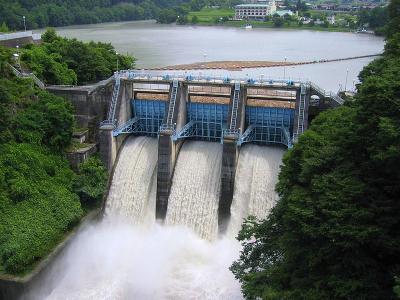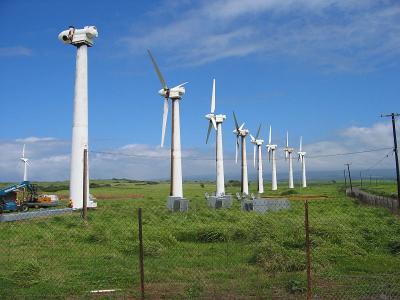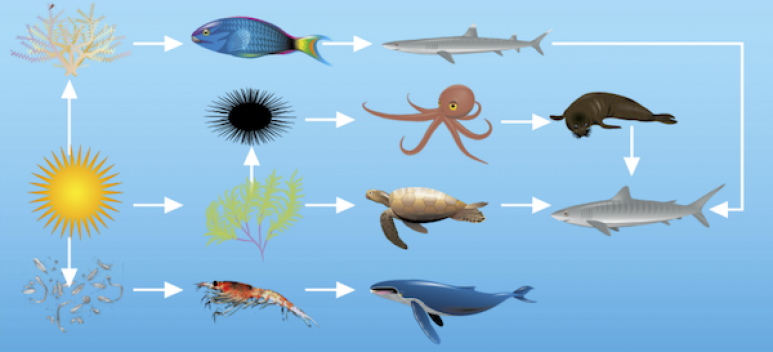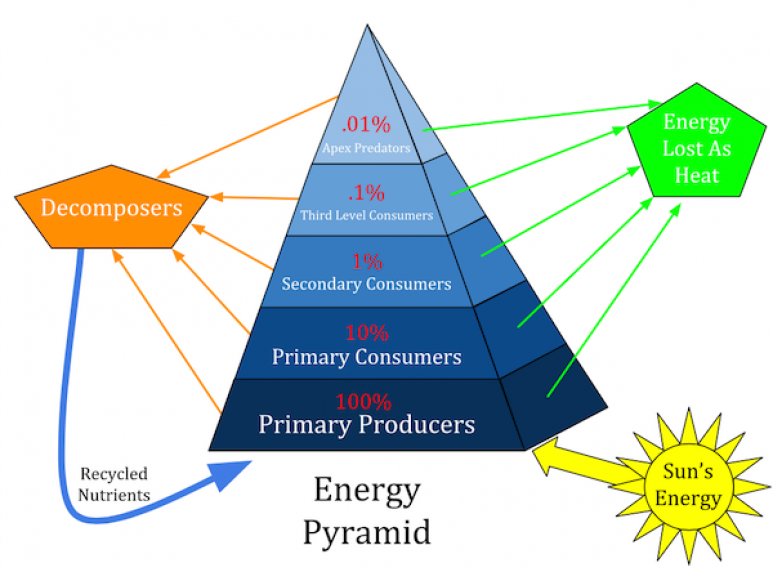Energy from the Sun
Clarification Statement: Examples of models could include diagrams and flow charts.
In ordinary language, people speak of “producing” or “using” energy. However, we when we say "produce energy" we actually mean to convert energy from one form into another. For example, the stored energy of water behind a dam is released when the water flows downhill and drives a turbine generator (Fig. 1A). Similarly, windmills allow us to capture energy when the wind is blowing (Fig. 1B).
Fig 1A. This dam in Japan can store energy when the water passes and spins a turbine generator.
Image courtesy of Wikimedia Commons
Fig 1B. The Kama'oa Wind Farm on the Big Island of Hawaii stores enery when the wind is blowing and converts it to electricity for future use.
Image courtesy of Wikimedia Commons.
Energy in Your Food
Fig. 2. This peanut butter food label gives nutrition and ingredient information.
Image by Emily Sesno
All of the energy we get from food can be traced back to the sun! Plants use energy from the sun to convert water and carbon dioxide into usable sugars, a process called photosynthesis. Those plants may then be eaten by bugs, who are eaten by animals, who are then eaten by larger animals. So, the whole process is powered by the sun!
The food we eat fuels our body to grow, heal, stay warm, and gives us energy throughout the day. In our everyday lives, we might eat a chicken that ate a caterpillar that ate a leaf that grew through photosynthesis. The labels on our food provide an ingredient list and nutrition facts to help us know what we are eating (Fig. 2).
Food Chains
Food chains are simplistic models that describe the feeding relationships among various species of organisms in an ecological community. Food chains are useful tools for understanding the trophic levels of organisms in an ecological community. Arrows are used to represent the transfer of energy from each level in a linear way (Fig. 3).
Fig 3. Limu (algae) → Wana (sea urchin) → He'e (octopus) → Puhi (eel) → Ulua (trevally)
Image by Emily Sesno
In this food chain example, the algae represent the primary producers, which are autotrophic organisms that make their own food by converting the energy from sunlight into food energy. Consumers are heterotrophic organisms that cannot produce their own food and must obtain food by eating other things. The sea urchin is a herbivore, an eater of plants or algae, and is a primary consumer in this example. Carnivores eat herbivores and other types of carnivores. The octopus is a carnivore, and because it is the first carnivore in the food chain, it is also a primary carnivore. The eel is a secondary carnivore. And finally, the ulua is the top predator in this food chain example because no other consumer eats it.
Food Webs
In a given ecosystem or community, many different food chains can be combined into a food web (Fig. 4). Food webs give a more realistic picture of feeding relationships.
Consider, for example, the food chain described above. In reality, the algae is eaten by sea urchins as well as by a variety of different species of fish and other invertebrates. In a food web diagram, many arrows can be used to point from the algae to multiple different organisms that feed on it. Likewise, other types of consumers eat sea urchins and octopus and eels. Many arrows can be drawn to account for the feeding relationships of the various organisms in the coral reef community.
Fig 4. A combination of different food chains make up a food web of a given ecosystem.
Image found in the interactive game from the original SEA material
The Transfer of Energy
Plants capture energy directly from the sun. All food sources can be traced back to plants. As the primary producers, plants sit at the base of the energy pyramid (Fig. 5). The different parts of the pyramid are called trophic levels. Only a fraction of energy actually gets transferred from one trophic level to the next. Most often, some energy is used to do work and some energy is lost as heat to the surrounding environment. The same idea can be applied to the energy our bodies need to survive. Each successively higher trophic level has less and less energy available. In a majority of communities, the drop in energy available at each trophic levels is reflected as a drop in the relative abundance (number of organisms) and total biomass (amount of living matter per unit area) of organisms. This is depicted by the smaller and smaller trophic levels within the pyramid.
Fig. 5. An energy pyramid shows that all energy in an ecosystem began as energy stored in plants from the sun.
Image courtesy of Wikimedia Commons
Conservation of Energy
Energy is conserved over time. Although some energy is lost as heat when animals digest their food, heat is also a form of energy. And, heat is an important type of energy for keeping mammals, like humans, warm. But, even when energy is lost as heat to the environment, the energy itself is not destroyed.
For example, when wood burns, most of the energy in the wood matter is converted into heat. Some of that heat will escape, and some may be captured to do work, like cooking or warming a house. And, some of the energy and matter from the wood will be left over in the form of ash (which can be added to soil and the remaining energy used by some organisms).
|
Energy from the Sun Vocabulary
|














